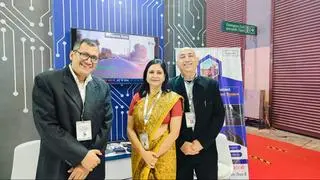After building a suite of data products at American Express using the huge amount of data on the bank’s servers, Rohit Kumar Pandey and his two co-founders felt they needed to do something else. Something more challenging, which would use the data analytical capabilities they had built and that would have more impact on society.
“Healthcare industry caught our attention because of multiple reasons,” says Rohit. One, the industry was gearing towards data. Google had acquired DeepMind, an Artificial Intelligence company, and Google Ventures (now GV) had expressed its intention to invest a third of its capital every year in the healthcare space. Third, and more importantly from their point of view, Rohit and his friends saw that there was a lot of data in healthcare, especially images, and there were very few people who were using it to come up with something interesting.
“That got us excited. The last bit was the social impact opportunity,” says Rohit. They took a baby step by downloading a freely available PAP smear data set from Kaggle, an online data science platform, and trained a simple model to predict whether this was cervical cancer positive or not. They approached a number of doctors in Bengaluru to tell them what they had built. Most of them told the trio that if they could implement it at scale and prove the accuracy, they have a business on hand. A few other doctors offered to support them in their venture. “We wanted to revolutionise the healthcare industry by data-driven intelligence,” says Rohit.
Overcoming the constraint
Rohit says they realised the constraints they would face, especially since there were privacy concerns over sharing medical data, and they expected digital data, which was not the case. They overcame all these and narrowed down their focus to high volume tests, such as blood and urine, which required a medical expert to review the visual data before the report is handed over.
According to him, in the course of doing the groundwork for their venture, they realised that the pathology industry worked on a hub-and-spoke model, simply because the number of pathologists required to do the job was not enough. The hub-and-spoke model, in turn, increased logistics costs, delayed the turnaround time and hence it took a long time to hand over the reports.
“In a nutshell,” says Rohit, “we saw three problems: inaccessibility, inaccuracy and unaffordability.” “We realised that we are going to solve these three problems when we are choosing this focus area,” he adds. Without digital data, it would not be possible for them to use Artificial Intelligence. The first hurdle they had to overcome was to digitise the data. With the help of start-up in Bengaluru, they came up with a way to digitise thousands of slides. The slides had to be annotated, for which they hired three pathologists.
Rohit says they found that the inter-observer variability among the three pathologists was 33 per cent, which means of the 100 images they sent, the three were aligned only on 67. “This is another important problem we were solving. We brought down the variability to 15-16 per cent.” They convinced pathologists that SigTuple’s model would not take away their jobs, but would only make it easier. It would do away with the tedious task of bending over microscopes and reading the slides.
According to Rohit, they decided to take a platform-centric approach to come up with more solutions, and came up with Manthana, an AI platform. The platform enabled the company to do the annotations that are typically done by a medical expert, do model training, and the pathologist can then give an opinion. The company also changed the hardware so that it can be used for multiple applications.
How it works
This is how SigTuple’s product works: a technician draws a blood sample and prepares a slide. This slide is inserted into the device that will digitise the slide and push it to the cloud-based platform. The platform has different AI, deep learning and statistical models to analyse the digitised slide and it will generate a report. The report will have visual evidence unlike other reports that have only numbers.
“This intelligent report is made available on the cloud to a pathologist on their handheld device. The pathologist can be anywhere. They can approve it without needing the blood sample or the slide or the microscope next to them. And, the entire process takes less than 10 minutes,” says Rohit.
SigTuple did the first commercial deployment of the device in April and since then has installed more than a dozen of them. It makes the hardware now in its premises, but has finalised an agreement with a medical device manufacturer to make the product.
With States wooing manufacturers, SigTuple may consider making the devices itself once its business crosses a certain threshold. The company gets its revenue through a pay-per-use model, which makes it easy for small labs and clinics to adopt this technology. They also don’t need to have a pathologist on their premises or depend on a larger lab for the pathologist. It has a 160-member team and the company will look to take its product to other similar global markets. It has applied for US FDA clearance.








Comments
Comments have to be in English, and in full sentences. They cannot be abusive or personal. Please abide by our community guidelines for posting your comments.
We have migrated to a new commenting platform. If you are already a registered user of TheHindu Businessline and logged in, you may continue to engage with our articles. If you do not have an account please register and login to post comments. Users can access their older comments by logging into their accounts on Vuukle.